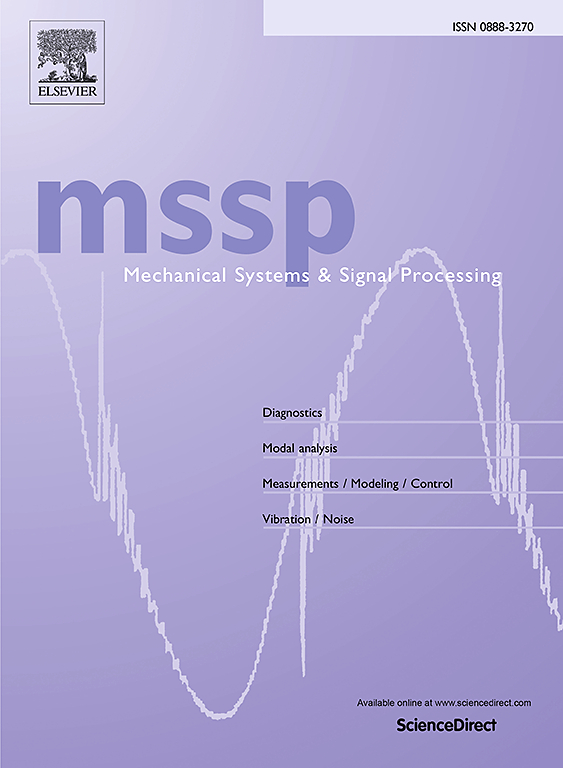High-fidelity analysis and experiments of a wireless sensor node with a built-in supercapacitor powered by piezoelectric vibration energy harvesting
IF 7.9
1区 工程技术
Q1 ENGINEERING, MECHANICAL
引用次数: 0
Abstract
A supercapacitor or an electric double layer capacitor (EDLC) is an essential component of a high-performance wireless sensor node (WSN) that can transmit the three-axis acceleration waveform data of structural vibrations and is powered by a piezoelectric vibration energy harvester (VEH). However, the intrinsically slow charging rate of the piezoelectric VEH triggers charging of extra capacitors formed inside the complex-shaped electrodes of the supercapacitor, which complicates the charging/discharging characteristics and thus estimation of the power generation and energy storage in the supercapacitor. Therefore, in this work, we establish an analytical methodology that allows accurate prediction of the charging/discharging characteristics of the supercapacitor built into the WSN powered by the piezoelectric VEH, considering (1) the nonlinear piezoelectricity, (2) a three-branch circuit model of the supercapacitor, and (3) the current–voltage relation equation for the diode. We develop a parameter identification technique for both the nonlinear piezoelectric VEH and the supercapacitor, and then establish a coupled analysis technique based on the differential algebraic equation (DAE). Using the DAE, we investigate the charging/discharging characteristics of the supercapacitor by considering the actual working steps of the WSN. We revealed that the second branch in the three-branch model contributes not only to an increase in the effective capacitance of the supercapacitor, but also to faster recovery of the voltage across the supercapacitor during WSN operation. We also revealed that a longer charging time led to more energy being stored in the capacitor in the third branch, from which it is difficult to extract energy within a short time period such as the WSN’s transmission process due to its long time constant. The contribution of the second and third branches must be considered to enable accurate prediction of the charging/discharging characteristics of the supercapacitor when built into the WSN powered by the piezoelectric VEH.利用压电振动能量采集技术对内置超级电容器的无线传感器节点进行高保真分析和实验
超级电容器或双电层电容器(EDLC)是高性能无线传感器节点(WSN)的重要组成部分,可传输结构振动的三轴加速度波形数据,并由压电振动能量收集器(VEH)供电。然而,压电振动能量收集器固有的缓慢充电速度会触发超级电容器复杂形状电极内部形成的额外电容器充电,从而使充放电特性复杂化,进而影响对超级电容器发电量和储能的估算。因此,在这项工作中,我们建立了一种分析方法,可以准确预测由压电 VEH 供电的 WSN 中内置的超级电容器的充电/放电特性,其中考虑到:(1)非线性压电性;(2)超级电容器的三分支电路模型;(3)二极管的电流-电压关系式。我们开发了非线性压电 VEH 和超级电容器的参数识别技术,然后建立了基于微分代数方程 (DAE) 的耦合分析技术。利用 DAE,我们考虑了 WSN 的实际工作步骤,研究了超级电容器的充放电特性。我们发现,三分支模型中的第二分支不仅有助于增加超级电容器的有效电容,还有助于在 WSN 运行期间更快地恢复超级电容器上的电压。我们还发现,充电时间越长,第三分支电容器中存储的能量就越多,而由于第三分支的时间常数较长,很难在短时间内提取能量,例如 WSN 的传输过程。必须考虑第二和第三支路的贡献,才能准确预测超级电容器内置到由压电 VEH 供电的 WSN 中时的充电/放电特性。
本文章由计算机程序翻译,如有差异,请以英文原文为准。
求助全文
约1分钟内获得全文
求助全文
来源期刊

Mechanical Systems and Signal Processing
工程技术-工程:机械
CiteScore
14.80
自引率
13.10%
发文量
1183
审稿时长
5.4 months
期刊介绍:
Journal Name: Mechanical Systems and Signal Processing (MSSP)
Interdisciplinary Focus:
Mechanical, Aerospace, and Civil Engineering
Purpose:Reporting scientific advancements of the highest quality
Arising from new techniques in sensing, instrumentation, signal processing, modelling, and control of dynamic systems
 求助内容:
求助内容: 应助结果提醒方式:
应助结果提醒方式:


